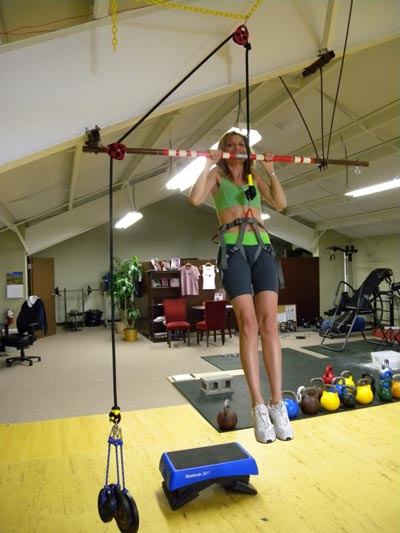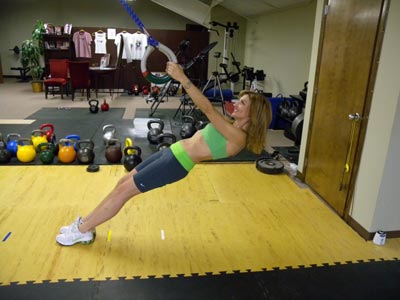Assisted Pull-up Mechanism
Jay Armstrong, RKC TL
January 12, 2010 02:31 PM
The Pull-up ProblemMany people cannot do even one pull-up. However, the ratio of strength to body weight is one measure of fitness. Gymnasts and rock climbers are among the elite in this area and they have the enviable physiques to show for it.

Sasha on the pull-up bar. Two pulleys and a climbing harness provides assistance.
Once you can do one pull-up you will be able to add weight or reps and increase your pull-up abilities. But, what if you cannot do even one pull-up? The lat pull down machine does not prepare you for the balance requirements of a pull-up. The best way to learn to do pull-ups is to do pull-ups!
If we can reduce your effective weight (or make you lighter) you will be able to do a pull-up. Elastic bands connected to the pull-up bar can provide some assistance but they are unstable, difficult to get into, and provide more assistance at the bottom of the pull-up where it is least needed.
ConstructionWhat follows is a description of a simple mechanism for assisted pull-ups. You will need the following materials to construct this mechanism:
(2) Pulleys
(1) Length of climbing rope
(2) Carabiners
(1) Climbing harness
The assistance for the pull-up is provided by weights attached to a rope. The rope is run through a couple of pulleys and connected to a climbing harness. I purchased (2) CMI RP-101 Pulleys for $30/ea and 50 ft of 5/8" Climbers rope at $1.59/ft from Tools for Stagecraft (www.toolsforstagecraft.com). This system provides a uniform and adjustable assistance for the pull-up. This system does not require a partner to assist in preparation for the pull-up.
Mount the first pulley almost directly over the bar. It must be slightly away from the bar so that the rope will not drag on the bar and so that the rope will not hit your face when your chin goes over the bar. Mount the second pulley somewhere to the side and out of the way. This second pulley is where the weights will be added for assistance.
Attach a carabiner to each end of the rope. Tie sturdy knots into the rope to limit the travel in both directions. You should be able to hang weight near the 2nd pulley and then grasp the other end of the rope and clip it to your harness. Carabiners can be purchased almost anywhere. I bought mine at Home Depot.
An inexpensive climbing harness is readily available from REI or other outdoor sports store. I purchased several before finding one that worked well for most of the class. I purchased CAMP Topaz Climbing Harnesses for $40 from Eastern Mountain Sports (www.ems.com). This harness is specifically designed to accept an upward force on a ring or loop. This ring is located near the belt buckle area. The harness is designed to transfer the load to the legs. It is adjustable for most sized bodies.
Limitation
Sasha on Rings. Body weight rows provide a way to a way to progress to Assisted pull-ups. Note the marks on the floor.
The practical limit for this system is 25 to 30 pounds. Why? There are two reasons. Firstly, when more than 30 pounds of assistance is employed using the climbing harness, the lower body will try to move forward rather than upward. (Of course, this depends on the body weight of the individual). Secondly, if the person using the system cannot do a pull-up with 30 pounds of assistance they probably cannot pull the rope downward to connect it to the climbing harness with any more weight.
Further AssistanceIf the individual cannot do a pull-up with 25 pounds of assistance he or she can begin to work up to this by doing body weight rows. The difficulty of the rows can be adjusted by varying the body angle. In my experience once you can do a horizontal body weight row you are close to doing a pull-up with 25 pounds of assistance.
As you can see from the photo, I placed marks on the floor. These marks were assigned hypothetical weight values. The horizontal position corresponded to 30 lbs of assistance and the nearly vertical position corresponded to 85 lbs of assistance. This allowed my students to vary the degree of difficulty in their pull-up practice.
The rings used for the body weight rows came from my friend, Charley Allen. He took some ?" PVC pipe, heated it in the oven, and bent it around a paint can. These didn't cost too much!
Putting it into PracticeNow that you have a way to vary the load of the pull-up exercise you can apply the waviness principles to your training. For example, you can do one pull-up with 10 lbs of extra weight (this is your 1RM). Some days you might train with 10 lbs of assistance (or use this as a warm-up set). Other days you might train with no weight.
Jay Armstrong is an RKC Team Leader. He holds a rank of 5th degree black belt from The World Tae Kwon Do Federation. Together with David Cogswell, RKC they founded The Kettlebell Club near Houston, Texas in 2005. The Kettlebell Club holds instructional workshops and offers daily group kettlebell workouts.
Contact Info:
Jay Armstrong
The Kettlebell Club
629 Hwy 3 South
League City, TX 77573
strengthcentral@kettlebellclub.com
281-332-0999
Back